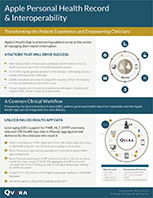Qvera Demonstrates Clinical Workflow with Wearables at HIMSS18
Apple’s recent announcement that health records can now be displayed in the iOS Health app is an encouraging step in the journey toward patient-centered healthcare.
One way patients can use the Health app to take an active role in their care is through wearable medical monitoring devices. Wearables can generate valuable information and data trends clinics can’t capture in one brief visit, and they have the potential to truly revolutionize care — as long as the data they produce is both reliable and relevant.
Unlocking iOS Health Data
At this year’s HIMSS conference, Mar. 5-9, Qvera demonstrated how the Qvera Interface Engine uses several data formats and transmission protocols to share useful information from a mobile blood pressure monitor, seamlessly and securely.
The demonstration worked like this:
- A patient filled out an HTML registration form, and Qvera Interface Engine used this data to create a new patient in OpenEMR.
- The Omron Wrist BP monitor captured the patient’s blood pressure and it was sent to the Health app via Bluetooth.
- QIE received iOS Health data via the Qvera Health Sync app. It aggregated the data and filtered the desired results (high, low and average BP).
- The results were then delivered to patient’s chart in OpenEMR for clinician review.
In this simple workflow, we showed how straightforward communication can be with QIE, even among several different devices running different types of software.
We also emphasized that QIE doesn’t just send raw data as it’s recorded, overwhelming clinicians and databases; instead, data can be extracted, filtered and aggregated, then directly integrated into a patient’s care.
The limitless potential of wearable medical devices
Taking data from wearables and sending it to the right places is easy with QIE. But what types of data can be generated, and where does this information need to go?
Development work on countless medical monitors is in progress, and coming years will see major advancements in this space. For now, we’re confident that QIE can transmit any data that can be integrated into the Health app, from pulse oximetry to glucose monitoring to mood screening. And while patients and doctors are obvious destinations for reported data, QIE can also optimize and transmit reports for research facilities, population health management and health registries.
We can’t predict which exciting device will be developed next — but we do know Qvera will be there to make sure patients stay connected.





